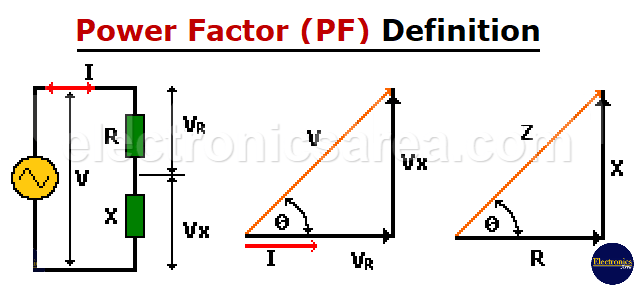Power Factor Definition
Power Factor (PF) is the ratio between the energy that is converted into work and the electrical energy consumed in a circuit or device. In other words, power factor is the ratio between the total voltage applied to a circuit and the voltage in the resistive circuit part. PF is also:
- Cosine of the angle (cos(φ)) between the real power vector and apparent power vector = Real Power/Apparent Power = Watts/Volts Amperes (W/VA)
- Cosine of the angle (cos(φ)) between impedance vector and resistance vector.
The AC power, consumed by a circuit with resistive elements (resistors) and reactive elements (capacitors and / or inductors) can be obtained with the following formulas: P = I x V x PF or P = IRMS VRMS x PF
Notes:
- RMS means Root Mean Square
- PF = Power Factor
See the circuit above and the corresponding phasor diagram. Although the diagram represents an inductive value, the procedure is valid in general.
The current (I) and voltage (VR) are in phase in the resistor R. The power (real power) dissipated in an impedance Z = (R + jX), is due only to resistance. Then: P = I x VR
From the phasor diagram: VR = V cos(0).
Combining the last two formulas we get: P = I x Vcos(0)
Comparing this equation with the expression: P = I x V x power factor, we conclude that: Power factor = cos (0). Where 0 is the phase angle of the impedance, or in other words, 0 is the angle between the voltage and current in the circuit.
Then PF = Cos(0) = VR/V = R/|Z|
Where: |Z| means the absolute value of Z (Z value is always positive, regardless of the sign)
The angle value will always be between:
- 0 °: Where V and I are in phase (fully resistive circuit). Cos (0) = 1, then PF = 1
- 90: When V and I are 90 ° out of phase (fully reactive circuit). Cos (0) = 0, PF = 0
We seek to have a power factor as high as possible, where cos(0) tends to “1” (most resistive possible).
How to correct the Power Factor?
PF correction is the process of compensating for current lagging relative to voltage by creating a leading current by connecting capacitors in parallel to the power supply.
With enough capacitance (capacitors) connected to the power source, the power factor is adjusted to be as close to unity as possible and losses are reduced and the electricity bill is reduced. A typical power factor of a company with P.F. it can reach 0.92 or a little more.
In the case of electric motors (through which an inductive current flows due to their coils), the PF can be corrected by putting capacitors in parallel with the motor’s starter. A disadvantage can appear when the load of the motor varies, an overcorrection of PF or the opposite can result.

